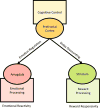Early life adversity and health-risk behaviors: proposed psychological and neural mechanisms
- PMID: 30011075
- PMCID: PMC6158062
- DOI: 10.1111/nyas.13928
Early life adversity and health-risk behaviors: proposed psychological and neural mechanisms
Abstract
Early life adversity (ELA) is associated with poorer health in adulthood, an association explained, at least in part, by increased engagement in health-risk behaviors (HRBs). In this review, we make the case that ELA influences brain development in ways that increase the likelihood of engaging in HRBs. We argue that ELA alters neural circuitry underpinning cognitive control as well as emotional processing, including networks involved in processing threat and reward. These neural changes are associated psychologically and behaviorally with heightened emotional reactivity, blunted reward responsivity, poorer emotion regulation, and greater delay discounting. We then demonstrate that these adaptations to ELA are associated with an increased risk of smoking cigarettes, drinking alcohol, and eating high-fat, high-sugar foods. Furthermore, we explore how HRBs affect the brain in ways that reinforce addiction and further explain clustering of HRBs.
Keywords: delay discounting; early life adversity; emotion regulation; emotional reactivity; health neuroscience; health-risk behaviors; reward responsivity.
© 2018 New York Academy of Sciences.
Conflict of interest statement
The authors declare no competing interests.
Figures


References
Publication types
MeSH terms
Grants and funding
LinkOut - more resources
Full Text Sources
Other Literature Sources
Medical

